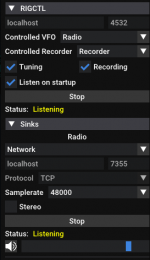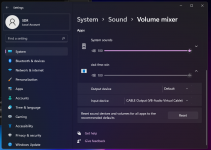All good. I had to force TCP port to 4532 and everything is working great.
Thanks
Thanks
All good. I had to force TCP port to 4532 and everything is working great.
cd dsd-fme
pulseaudio.exe --start --no-cpu-limit=TRUE --exit-idle-time=3600
ECHO The Pulse Audio Server should now be active!
@REM dsd-fme -fs -i tcp -U 4532 -T -C examples\ctm-site.csv -G examples\ctm-group.csv -N 2> log.ans
dsd-fme -fs -i tcp -U 4532 -T -C examples\ctm-site.csv -K examples\multi_key_hex.csv -N 2> log.anscd dsd-fme
pulseaudio.exe --start --no-cpu-limit=TRUE --exit-idle-time=3600
ECHO The Pulse Audio Server should now be active!
@REM dsd-fme -fs -i tcp -U 4532 -T -C examples\ctm-site.csv -G examples\ctm-group.csv -N 2> log.ans
dsd-fme.exe -o pulse -fs -i tcp -U 4532 -T -C examples\ctm-site.csv -K examples\multi_key_hex.csv -N 2> log.ans
@REM Shutdown pulseaudio
pactl.exe exit
-i tcp:127.0.0.1:7355cd dsd-fme
pulseaudio.exe --start --no-cpu-limit=TRUE --exit-idle-time=3600
ECHO The Pulse Audio Server should now be active!
@REM dsd-fme -fs -i tcp -U 4532 -T -C examples\ctm-site.csv -G examples\ctm-group.csv -N 2> log.ans
dsd-fme -o pulse -fs -i tcp:127.0.0.1:7355 -U 4532 -T -C examples\ctm-site.csv -G examples\ctm-group.csv -N 2> log.ans
pactl.exe exitAre there any known issues with NXDN4800 decoding currently on the Windows build? I have a few wav files that decode fine and show call activity when piped into DSDPlus, however FME doesn't show any call activity at all. I'm quite puzzled with this. I've been using this command line..
dsd-fme.exe -i audio\nx48.wav -s 96000 -o pulse -Z -fi -N 2> log.ans
Switching to -fn and using an NX9600 wav file play just fine. But I can't get 4800 to work at all for some reason....
How can I specify the audio output from dsd-fme to vb cable with pulse audio?
I'm piping data from sdr++ via TCP and would like to pipe decoded audio to Zello via vb cable.

Anyone had luck running DSD-FME with rtl_fm on a raspberry pi?
dsd-fme -fs -i rtl:0:450M:0:12:2 -T -C examples/ctm-site.csv -G examples/ctm-group.csv -N 2> log.ansRTL-SDR options:
Usage: rtl:dev:freq:gain:ppm:bw:sq:udp
NOTE: all arguments after rtl are optional now for trunking, but user configuration is recommended
dev <num> RTL-SDR Device Index Number
freq <num> RTL-SDR Frequency (851800000 or 851.8M)
gain <num> RTL-SDR Device Gain (0-49)(default = 0; Hardware AGC recommended)
ppm <num> RTL-SDR PPM Error (default = 0)
bw <num> RTL-SDR Bandwidth kHz (default = 12)(8, 12, 16, 24)
sq <num> RTL-SDR Squelch Level vs RMS Value (Optional)
udp <num> RTL-SDR Legacy UDP Remote Port (Optional -- External Use Only)
Example: dsd-fme -fs -i rtl -C cap_plus_channel.csv -T
Example: dsd-fme -fp -i rtl:0:851.375M:22:-2:24:0:6021dsd-fme -fs -i rtl:0:447.625M:49:0:2:40 -o pulse -N 2> log.ansdsd-fme -fs -i rtl:0:447.625M:0:0:8 -o pulse -N 2> log.ansdsd-fme -fs -i rtl:0:447.625M:0:0:12 -o pulse -N 2> log.ansrtl:dev:freq:gainpm:bwYou know, I honestly don't truly know if there is an optimal percent in level. Somebody earlier mentioned that they thought they got better decodes at around 50%, but I've had good decodes at low levels and at higher levels. I honestly just think its more of a system to system, or sample to sample. The % meter can also exceed 100 percent, so you know, that's also a thing.Quick question regarding the In Level percentage... is there an optimal value you should be shooting for there? 100%?

